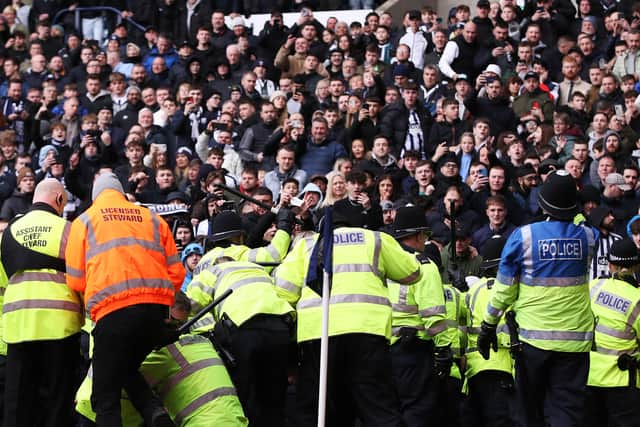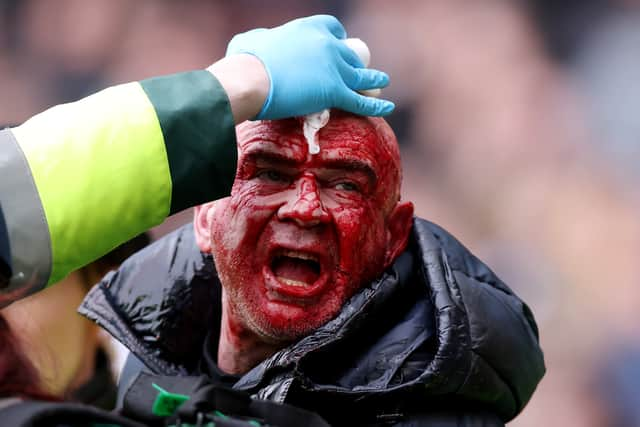The violence at West Brom v Wolves proves the need for the authorities to try something new
and live on Freeview channel 276
Fights in the crowd, footballers carrying their children to safety, police batons flailing wildly and a man being escorted down the sidelines with blood streaming from his scalp – pictures that should belong in grainy analogue footage from the darkest days of English football hooliganism, but which were captured in modern digital clarity on Sunday afternoon. The scenes of violent disorder at the Hawthorns were grim in their own right, but were made even more so because they were entirely predictable.
It had been 12 years since West Bromwich Albion and Wolverhampton Wanderers last met in the Black Country derby. Back in 2012, the resultant violence would have been unthinkable. There have always been small pockets of fans only too willing to surrender self-control and give into their worst primal instincts, but after years of struggle, it felt as though the authorities had won the war against hooliganism. On current evidence, the fight is beginning anew.
Advertisement
Hide AdAdvertisement
Hide Ad

The chaotic and destructive events that saw the FA Cup fourth round game suspended for 38 minutes may not yet be a weekly feature of the game, but they were scarcely unprecedented. In early 2023, it emerged that reports of incidents at a game, from pitch invasions to missile thrown from the stands, were at their highest levels in almost a decade. That itself was unsurprising to anyone who had witnessed the chaotic disorder at Wembley in 2021 ahead of the European Championship final between England and Italy.
Post-lockdown delirium was often offered up a possible cause for the trouble that suddenly became so much more pervasive around that time, but it has been years since our freedoms were restored after the first waves of the coronavirus pandemic, and there is little sign of a return to the old normal.
Police, politicians and the FA all have suggestions for the root causes. An increase in the use of Class A drugs is often cited, and that won’t shock anyone who has used the toilets in a Premier League stadium in the last few years. But whatever the reasons for the spike in violence, and whatever sparked the disgraceful behaviour in the Midlands this weekend, the blunt fact is that there is a problem – and the only question is what to do about it.
The authorities have struggled to get ahead of the issue. In 2022, the FA responded to the increase in reports of disorder after lockdown by strengthening the pathways by which offenders were reported to the police, and an increase in Football Banning Orders handed down by the courts followed, but it does not seem to have proven sufficient deterrent.
Advertisement
Hide AdAdvertisement
Hide AdThe police themselves still police matches in much the same way as they did before, but Sunday’s events suggested that they have not got a firm handle on how to quell unrest in the ground. The reaction to an outbreak of violence in one corner of the Hawthorns was to push back hard, and it’s hard to imagine that the officer who was seen windmilling his baton indiscriminately into the fans in front of him achieved much by way of defusing the situation.
On 29 December 2023, a select committee from the Department of Culture, Media and Sport published a report into safety at major sporting events. It offered up a wide range of recommendations, including the introduction of a law to deter ticketless fans from attempting to gain entry into stadiums and the creation of a central system to identify and report fans who are responsible for discrimination or antisocial behaviour at games.
It also asked police to undertake “further work” to “understand the prevalence of drug supply and possession at sporting events,” although it stopped short of suggesting how that be done. It is quite clear that police are still behind the gun at games, ready to respond to incidents after they occur but not acting to prevent them before they take place.
There have been some efforts to improve preventative measures, including an increase in the use of sniffer dogs, but either there is a lack of necessary resources to get the job done to a sufficient extent, or a lack of understanding of how to use the resources that police and stewards do have.
Advertisement
Hide AdAdvertisement
Hide AdStewarding is another area in which huge improvements could be made, and also comes up in the government report. It recommends that stewards be given better treatment and more appropriate wages, which are both entirely reasonable given the greatly increased difficulty and danger of their role, but there is also a glaring need for improved training and support. Stewards remain a first line of defence against pitch invaders and are often first responders if there are incidents in the stand, but they are neither equipped nor encouraged to step in to situations of violent disorder and are not effective at preventing drugs and missiles from being taken into the stadium. Too much contraband gets in, and too little is done to prevent it.
Stewards do a crucial and often thankless task, and more should be done to give them both the tools they need and improved pay commensurate to the importance of their work – which would also have the benefit of helping to retain experienced stewards. Too much work is being done by people who are either too inexperienced or too poorly trained to be effective.


As it stands, the FA and the police need to re-evaluate how they handle antisocial behaviour in the crowd and how they work to stub out the root problems – or the Hawthorns won’t be the last match marred but such acts of violence, and it seems likely that the same root cause will also partly explain the uptick in discriminatory behaviour reported at matches in recent times. Racism and homophobia have been increasingly commonplace at games.
It's also fair to say that drugs, while likely one important issue behind the worsening behaviour at men’s football matches, are not the only contributing factor. There is a worry that the violence is increasingly organised, both in England and in other countries which have had similar problems such as France and the Netherlands.
Advertisement
Hide AdAdvertisement
Hide AdHooligan ‘firms’ were a major driving force behind the constant violence that blighted and damaged the game from the Seventies to the Nineties, and reducing their influence and membership was an important factor in making the sport safe again and bringing dwindling crowds back to matches. Now police believe that organised football hooligan groups have been behind several acts of violent disorder, and they were partly blamed for attacks that occurred during pro-Palestine marches in London last November. If such organisations are permitted to take a foothold in English football culture again, it essentially guarantees a worsening of the situation.
Whatever you choose to believe are the main causes and whatever your preferred solutions, the only people who gain from a return to the chaos and fear of the bad old days of English hooliganism are people who revel in punctuating their sporting experience with violence and destruction. The FA and the police need to look at the problem with a fresh pair of eyes, because what they are doing is not enough. The West Brom and Wolves game needs to act as a wake-up call, and hopefully a full stop.
Comment Guidelines
National World encourages reader discussion on our stories. User feedback, insights and back-and-forth exchanges add a rich layer of context to reporting. Please review our Community Guidelines before commenting.
